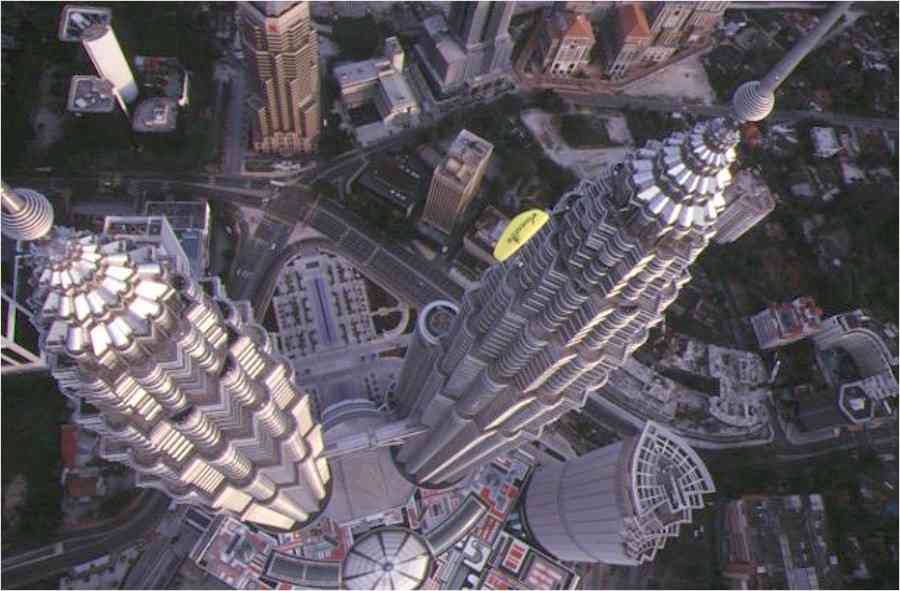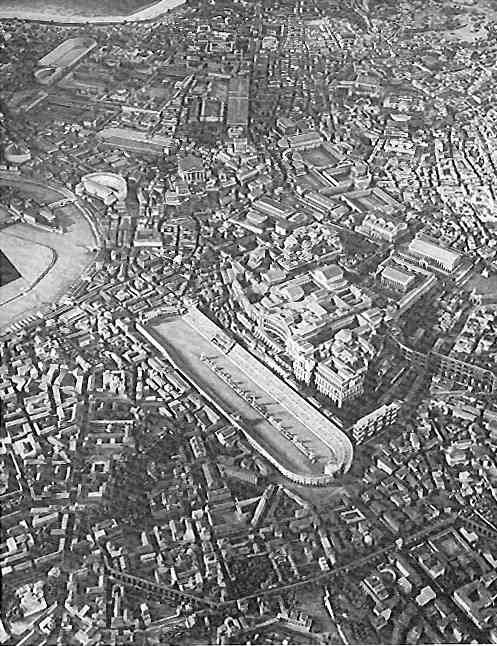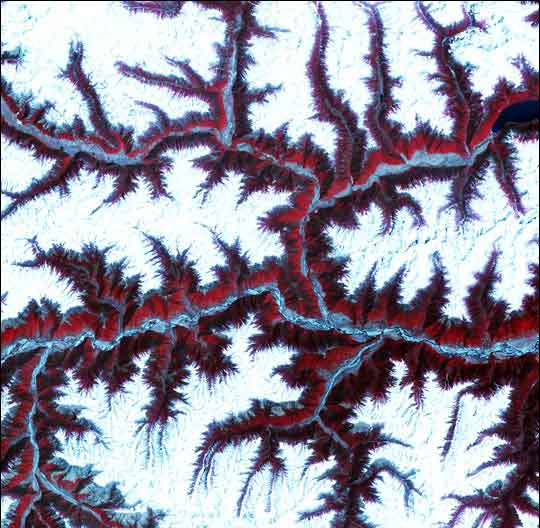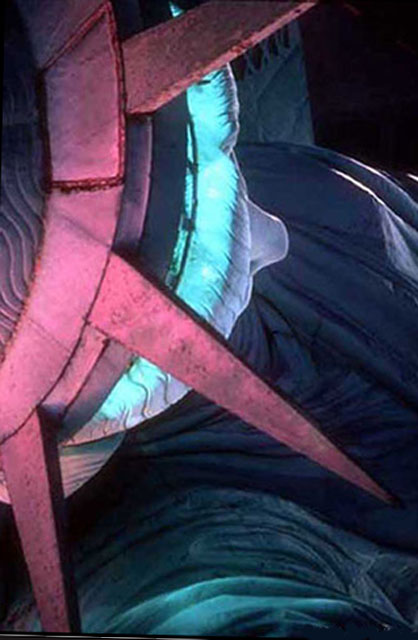Every City Wants to Have the Tallest One
Coming in from AboveThe City of New York is like an enormous citadel, a modern Carcassonne. - Henry V Miller
Petronas Twin Towers otherwise known as Menara Kembar Petronas Source: somewhere on the website attractievestad.nl - I lost the exact reference and when I went back through the site, this picture appeared to have been removed. The site is a Mecca for skyscraper lovers, with some truly stunning pictures and is probably worth a visit.
The current “world’s tallest skyscraper” titleholder, the 101-story tower completed in Taipei in 2004, stands at 1,666 feet. When it is completed in 2008, the Lotte World II Tower in Busan, South Korea, will edge 7 feet higher. The Burj Dubai, an epochal construction, stands now at about 1,000 feet with only 90 of its planned 160-plus stories completed; when it is finished in 2009, it may top out at over 2,600 feet — however, just as in the great Manhattan skyscraper race of the late 1920s (which the Chrysler Building won with its extended spire before being dwarfed in 1931 by the Empire State Building), the true planned height is a closely guarded secret. The Burj Dubai’s lead architect, Adrian Smith (until recently with the Chicago office of Skidmore, Owings & Merrill but now doing business as Adrian Smith + Gordon Gill Architecture), says that as soon as the final number is announced, a competing developer in Dubai will release plans for an even higher tower... (from "Lust for Height" by Philip Nobel, american.com 23 February 2007).
Closer to Earth
Source: attractievestad.nl See also:
Maybe These Weren't Skyscrapers - Nevertheless, This Was a Great City...
Cosmopolitan Rome as it likely looked in 300AD. Source: attractievestad.nl I read that Circus Maximus was occasionally filled with water so that the spectators could be treated to battles between ships...
Animal Magic of Rome's Colosseum Underworldby Michael Leidig in Munich The Colosseum in Rome was as sophisticated as a modern stage set, according to archæologists who have calculated how an intricate system of gangplanks, trapdoors and levers was used to bring wild animals into the arena. Under the 55,000-seat Colosseum, pulleys and ropes were operated at split-second intervals to connect passages, open gates and hoist cages from the basement to the arena floor. The system was run by teams of slaves who faced being fed to the animals themselves if their timing went awry. A team from the German Archæological Institute involved in an 8-year project to rebuild the arena - which was built about 70AD - has been astonished by the ingenious designs. (Although the basement of the Colosseum was due to be excavated in 1812, the water-table was too high at the time and the area was covered over again. Until now, it has never been properly investigated.) By measuring the floor space and cavities in the walls where wooden lifts, levers and cages would have been constructed, and comparing their findings with contemporary accounts of how animals "magically appeared", the archæologists have pieced together how the mechanisms worked. Beneath the arena's grandeur lay a netherworld of gladiatorial schools and storerooms, all linked by corridors filled with pulleys and levers, animal cages and gladiators. "We can tell that two or three different mechanical systems were installed," Heinz-Juergen Beste said. "We have found more than 28 lifts used to get animals into the Colosseum. With a pull of a lever they could send scenery, artificial forests or castles made of papier-mâché into the arena. The animals were taken down into the basement where they were put into cages. From there they were hauled up to a second level and the door to the cages opened. The beasts would then run up ramps and out into the arena." The highlight of a typical Colosseum performance was the afternoon gladiatorial contest, run to a tight timetable by slaves who worked in poor conditions. "The spectators would have had plenty of light, but below ground it was a very different story," Dr Beste said. "It would have been very dark, with just a few candles or an oil lamp." The first recorded fights between gladiators took place in 264BC and spread rapidly with the growth of the Roman empire. At the height of the empire, a network of at least 186 amphitheatres stretched from Westphalia, Germany, to the Euphrates. The Colosseum was the largest and most prestigious arena, where emperors consolidated their reputations by staging ever larger games. Rhinoceros and bulls were originally pitted against each other but their popularity led to more exotic creatures being sought. Camels, zebras, tigers, lions and leopards were shipped from across the world. Maltreatment was part of the Colosseum menagerie regime. "[Beasts] were starved, had salt poured into wounds, were taunted and thrown straw dummies of men to make them fighting mad - and then they were released," Dr Beste said. Source: smh.com.au 16 December 2003 from The Telegraph, London See also:
Himalayas from Overhead
Soaring, snow-capped peaks and ridges of the eastern Himalaya Mountains create an irregular white-on-red patchwork between major rivers in southwestern China. The Himalaya are made up of three parallel mountain ranges that together extend more than 2,900 kilometres. This scene was acquired by the Advanced Spaceborne Thermal Emission and Reflection Radiometer (ASTER), flying aboard NASA’s Terra satellite, on 27 February 2002. Source: livescience.com
Lady Liberty from Overhead
Down on Liberty! Source: nikonnet.com © Peter B Kaplan 2006
For photos of the earth and moon, stained glass, sunsets on Wellington Harbour, Lady Fair, Civic Square, the old mill, the Whippany River, historical houses, Lake Parsippany and more clicking
the "Up" button below takes you to the Index page for this Photographs section. |
 Animals
Animals Animation
Animation Art of Playing Cards
Art of Playing Cards Drugs
Drugs Education
Education Environment
Environment Flying
Flying History
History Humour
Humour Immigration
Immigration Info/Tech
Info/Tech Intellectual/Entertaining
Intellectual/Entertaining Lifestyles
Lifestyles Men
Men Money/Politics/Law
Money/Politics/Law New Jersey
New Jersey Odds and Oddities
Odds and Oddities Older & Under
Older & Under Photography
Photography Prisons
Prisons Relationships
Relationships Science
Science Social/Cultural
Social/Cultural Terrorism
Terrorism Wellington
Wellington Working
Working Zero Return Investment
Zero Return Investment



